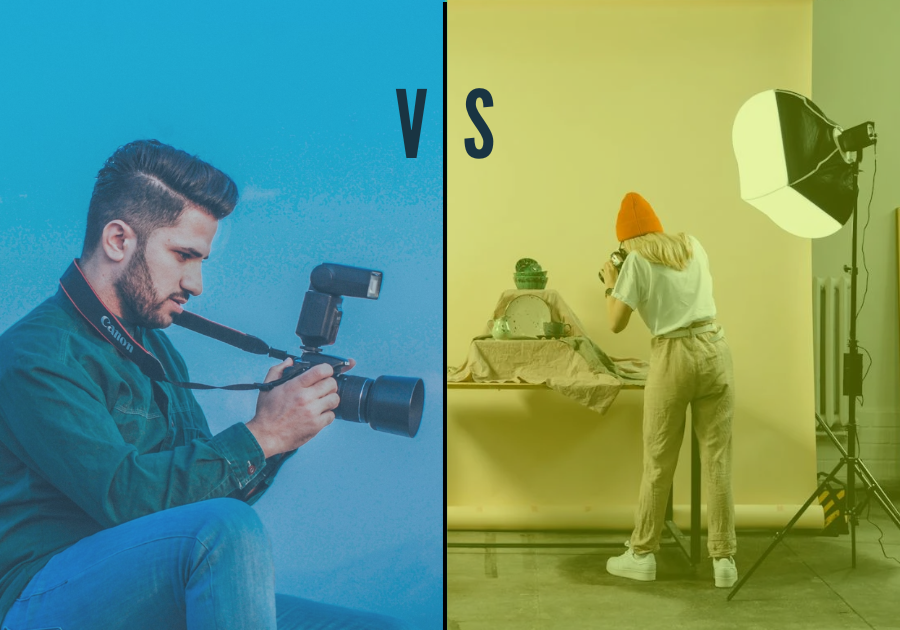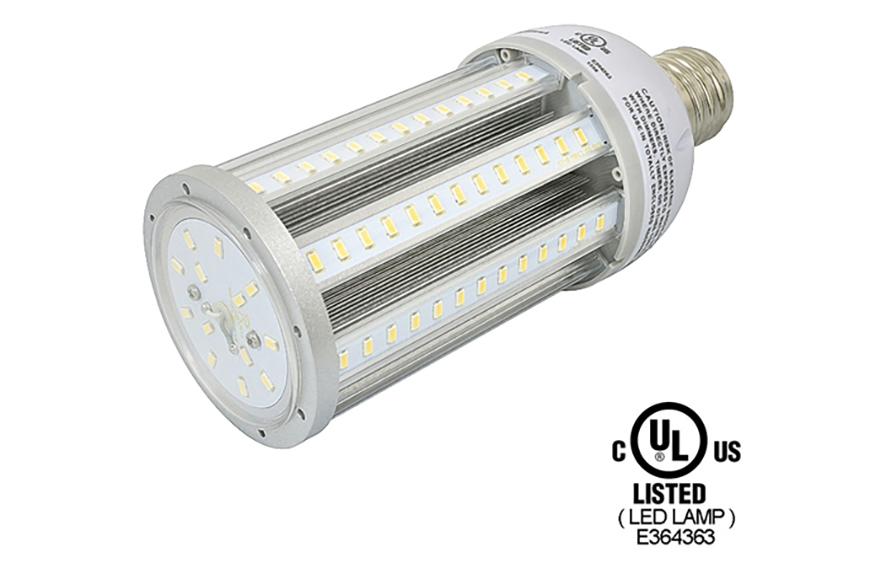
This is a guide comparing strobe and continuous lighting for photography.
Choosing the right light source for your shoot is crucial for bringing enough light to the scene to capture all the details.
I use both off-camera flash and LED lights for photography and video work to help freeze action and bring my subjects to life.
Here, I’ll explain the differences and give you a complete breakdown of the best lighting options for all shooting scenarios.
What Are Strobe Lights?
A strobe light is a light that triggers a pulse of light when activated rather than delivering a constant source of light.
Strobes are activated when the shutter is triggered, then go dark again until the shutter triggers the next strobe light pulse.
Many commercial photographers use strobe lighting for modeling gigs and other projects revolving around shooting human subjects.
Let’s look at some common types of strobes.
On-Camera Flash
Credit: Alessio Medini
Most photographers will have their first experience using strobe lighting with their on-camera flash, the simplest form of the concept.
These are built into the camera and deliver a direct pulse of light when aimed at the subject and activated.
On-camera flashes can also be used to trigger off-camera flashes through the commander mode to enhance the creative possibilities.
Speedlight

Credit: Dante Muñoz
A speedlight is a separate flash unit that offers more scope for versatility by allowing photographers to control the direction of the output.
This makes it possible to introduce more dramatic lighting into your photo shoots.
Speedlights also differ from on-camera flashes in that they require a separate power source to operate.
Major camera manufacturers such as Nikon, Canon, and Sony produce speedlights for their cameras, with third-party options also available.
Monolights and Strobe Heads

Credit: Amar Preciado
If you need a strobe light with more power, monolights and strobe heads combine a flash and power supply into a single unit.
Such lights are typically larger than speedlights and tend to be used by professional photographers with more demanding expectations.
What Are Continuous Lights?
A continuous light is a light source that remains constant during operation, often designed to mimic different natural lighting conditions.
This can include LED lights, older tungsten-based lighting rigs, compact fluorescent lights, and plasma lights.
Continuous lights are frequently used for video content creation as well as photography, due to their predictability and overall consistent results.
How Much Do You REALLY Know About Photography?! 🤔
Test your photography knowledge with this quick quiz!
See how much you really know about photography…

LED Panels

Credit: Dennis Truong
LED panels are perhaps the most common technology used for modern continuous lighting. These deliver a strip of lights arranged in a grid.
They can be operated using a mains power supply or batteries and can be easily positioned in a studio using a light stand.
Modern LEDs also offer full RGB color programming and variable saturation and hue to open up new creative possibilities.
Monolight-Style LEDS

Credit: Mart Production
Monolight-style LEDs offer a compact and practical solution to a range of photography scenarios with high-quality performance.
Closer in design to traditional studio lights, they replace the traditional flash tube with LEDs and cast bright light from a single source.
COB LED Light

Credit: LED Bulbs 123, CC BY-ND 2.0 DEED, via Flickr
A chip-on-board LED light, or COB LED, is a device that comes with multiple LED chips mounted on a substrate designed for thermal efficiency.
They have a higher density of light output and use fewer components than standard LED lighting rigs, with longer lifespans.
Strobe vs Continuous Lighting: Pros and Cons
Both strobe and continuous light rigs have optimal shooting scenarios where they can deliver the best possible results depending on your photography requirements.
Here’s an overview of the advantages and disadvantages you should consider when deciding which type to use for your next project.
Strobe Lights
- Crisp and tack-sharp images
- Optimal for freezing motion
- Easy to power with lithium batteries
- Minimize the impact of camera shake
- Diminish unwanted ambient light
- Allow for lower ISO settings
- Require a syncing device
- Increase the need for test shots
- A flash-triggering system is required
Continuous Lights
- Quick and easy-to-see results
- Great for achieving cinematic aesthetics
- No heat issues with LEDs
- Optimized for a video workflow
- Full-color temperature control
- Require a fast shutter speed in some scenarios
- Older models can be prone to overheating
- Can struggle to overcome ambient light
While both types of light have issues to be mindful of, it’s worth noting that technological advancements have reduced these issues over time.
We can anticipate such issues to be ironed out as new lights emerge capable of performing optimally in various shooting scenarios.
Strobe Lights vs Continuous Lights: Which Should I Use?
Now that I’ve explored the key differences between continuous and strobe lighting, let’s put this in context to help you choose the right one for your needs.
Here are several common situations photographers face, and actionable tips on the best lighting rig you can try yourself.
Indoor Shoots
Indoor photography offers a great degree of flexibility when it comes to lighting options and will vary depending on the level of available natural light.
Many photographers opt for a large continuous light rig for their studio work since these can deliver enough power and are cool to the touch.
They also offer white balance-friendly performance and daylight fluorescence and allow the subject to move freely within the space.
With that said, there’s certainly a place for strobes when shooting indoors since they can enhance the level of creative options.
Battery-powered strobes are incredibly flexible and can be quickly repositioned around the subject to experiment with different aesthetics.
Outdoor Shoots
Your choice of lighting for outdoor shoots will vary depending on the composition and number of subjects you’re including in a shot.
Strobes can deliver more power and control compared to continuous lights since they’re generally brighter and lighter to move.
Outdoor shoots often take place in bright sunlight, which renders continuous lights less useful due to their lower output.
With that said, if you’re shooting portraits with relatively tight framing, continuous lights can help fill in these limited scenarios.
Product Photography
When it comes to product photography, continuous lights are the best option to go for, since they offer consistent and predictable results.
Using a continuous LED also allows you to explore various color options across the full spectrum of RGB light range.
It also gives you more control over how the light falls on the product to accentuate dominant features and create interest through shadows.
Some photographers use strobe lighting for product shoots since there are more options for using light modifiers to adjust the light’s qualities.
Recently, however, more continuous light models are compatible with a range of modifiers, and even household lamps can work well.
Video
While strobes and continuous lights have various photography applications, most videographers only use continuous lights for their shoots.
There are some exceptions to this rule where strobes are used for effect, such as in nightclub scenes, but on the whole, strobes aren’t an appropriate choice.
If you’re working in videography and filmmaking, bear in mind that continuous lights designed for outdoor use can be prohibitively expensive.
You can avoid such costs by using reflectors to help bounce natural light into your shots and achieve a quality look.
Stop Motion Photography
As with video content creation, stop-motion animation uses continuous lights to offer a consistent look from one frame to the next.
Since stop-motion animation rigs are relatively small, you don’t need to invest in large and expensive lights to get impressive results.
Additionally, LEDs can be left running for long periods without overheating, which makes them ideal for the painstaking work of animation.
Event Photography
Event photography can be especially challenging since it requires moving around a location with unpredictable available light sources.
This makes flash lighting a great option for quickly introducing additional light when needed, combined with bounce and angles to modify the results.
This means opening up your options and using off-camera flashes that allow you to reposition your light source depending on the shot.
FAQ
Are strobe lights better than continuous lights?
While both strobe and continuous lights have their advantages, strobes are more commonly used for various photography requirements.
On the other hand, if you’re primarily working as a videographer, you’re more likely to be using continuous lights as your primary light source.
Is continuous light or strobe better for product photography?
If you’re a photographer shooting products for a client, the best results tend to come through constant lights using a softbox.
This will help to ensure a consistent light output for your images, particularly when used in combination with a reflector.
Do strobes work well outside?
Shooting outdoors with a strobe poses several challenges that need to be addressed, particularly when dealing with natural light sources.
You may need a higher power output for the strobes to compete with ambient lighting depending on the distance your lights are from the subject.
It’s also possible to compensate for these restrictions by altering your shutter speed and ISO camera settings to improve results.
What are the disadvantages of continuous lighting?
Using continuous light is a great way to guarantee a consistent and constant light source, but there are potential drawbacks to consider.
Continuous lights are less powerful than strobes and can be prone to overheating over prolonged periods of use.
They also can’t be used as effectively to freeze motion compared to their strobe lighting counterparts.
Can you combine strobe and continuous lighting?
Combining continuous light with strobe lighting is a great way to bring more control to the style of shooting and potential results.
This combination can help you achieve sharper images with more refined detail, particularly when shooting subjects in motion.
It’s also an effective way to simulate natural and ambient light effects, such as replicating the glow of golden hour photography.
Credit : Source Post



